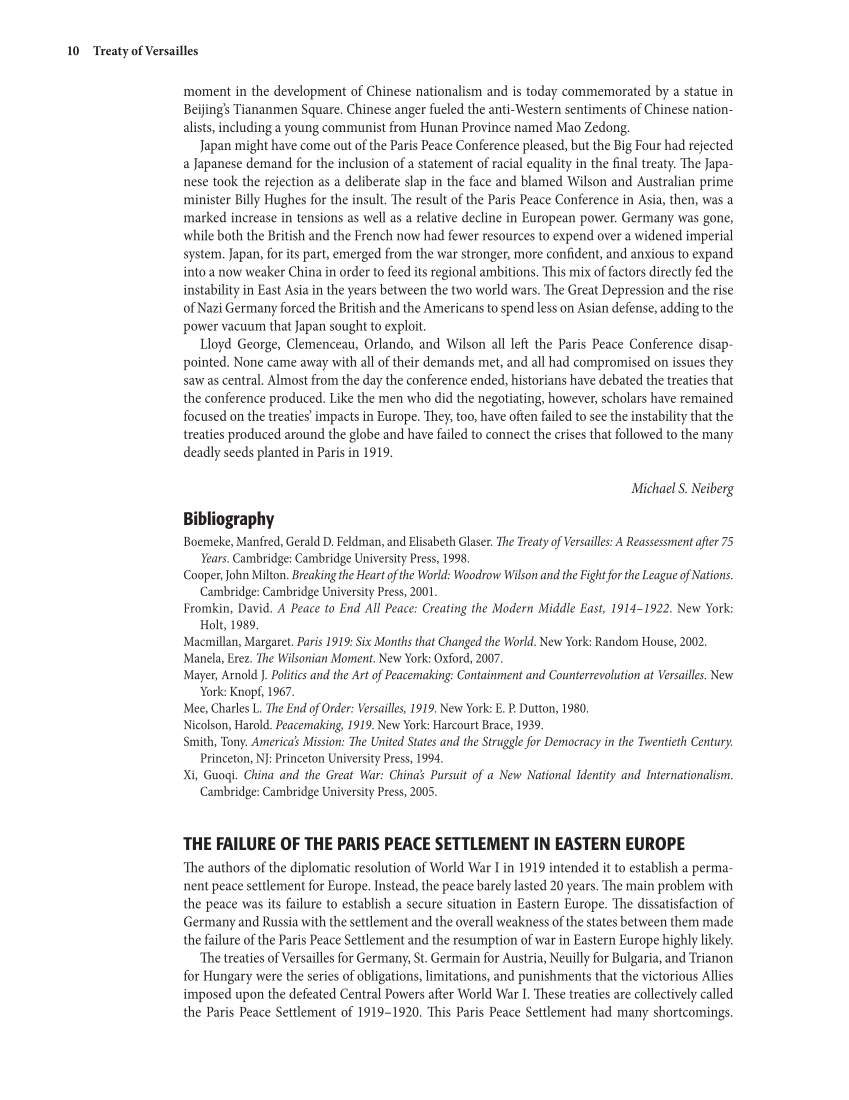10 Treaty of Versailles moment in the development of Chinese nationalism and is today commemorated by a statue in Beijing’s Tiananmen Square. Chinese anger fueled the anti-Western sentiments of Chinese nation- alists, including a young communist from Hunan Province named Mao Zedong. Japan might have come out of the Paris Peace Conference pleased, but the Big Four had rejected a Japanese demand for the inclusion of a statement of racial equality in the final treaty. The Japa- nese took the rejection as a deliberate slap in the face and blamed Wilson and Australian prime minister Billy Hughes for the insult. The result of the Paris Peace Conference in Asia, then, was a marked increase in tensions as well as a relative decline in European power. Germany was gone, while both the British and the French now had fewer resources to expend over a widened imperial system. Japan, for its part, emerged from the war stronger, more confident, and anxious to expand into a now weaker China in order to feed its regional ambitions. This mix of factors directly fed the instability in East Asia in the years between the two world wars. The Great Depression and the rise of Nazi Germany forced the British and the Americans to spend less on Asian defense, adding to the power vacuum that Japan sought to exploit. Lloyd George, Clemenceau, Orlando, and Wilson all left the Paris Peace Conference disap- pointed. None came away with all of their demands met, and all had compromised on issues they saw as central. Almost from the day the conference ended, historians have debated the treaties that the conference produced. Like the men who did the negotiating, however, scholars have remained focused on the treaties’ impacts in Europe. They, too, have often failed to see the instability that the treaties produced around the globe and have failed to connect the crises that followed to the many deadly seeds planted in Paris in 1919. Michael S. Neiberg Bibliography Boemeke, Manfred, Gerald D. Feldman, and Elisabeth Glaser. The Treaty of Versailles: A Reassessment after 75 Years. Cambridge: Cambridge University Press, 1998. Cooper, John Milton. Breaking the Heart of the World: Woodrow Wilson and the Fight for the League of Nations. Cambridge: Cambridge University Press, 2001. Fromkin, David. A Peace to End All Peace: Creating the Modern Middle East, 1914–1922. New York: Holt, 1989. Macmillan, Margaret. Paris 1919: Six Months that Changed the World. New York: Random House, 2002. Manela, Erez. The Wilsonian Moment. New York: Oxford, 2007. Mayer, Arnold J. Politics and the Art of Peacemaking: Containment and Counterrevolution at Versailles. New York: Knopf, 1967. Mee, Charles L. The End of Order: Versailles, 1919. New York: E. P. Dutton, 1980. Nicolson, Harold. Peacemaking, 1919. New York: Harcourt Brace, 1939. Smith, Tony. America’s Mission: The United States and the Struggle for Democracy in the Twentieth Century. Princeton, NJ: Princeton University Press, 1994. Xi, Guoqi. China and the Great War: China’s Pursuit of a New National Identity and Internationalism. Cambridge: Cambridge University Press, 2005. THE FAILURE OF THE PARIS PEACE SETTLEMENT IN EASTERN EUROPE The authors of the diplomatic resolution of World War I in 1919 intended it to establish a perma- nent peace settlement for Europe. Instead, the peace barely lasted 20 years. The main problem with the peace was its failure to establish a secure situation in Eastern Europe. The dissatisfaction of Germany and Russia with the settlement and the overall weakness of the states between them made the failure of the Paris Peace Settlement and the resumption of war in Eastern Europe highly likely. The treaties of Versailles for Germany, St. Germain for Austria, Neuilly for Bulgaria, and Trianon for Hungary were the series of obligations, limitations, and punishments that the victorious Allies imposed upon the defeated Central Powers after World War I. These treaties are collectively called the Paris Peace Settlement of 1919–1920. This Paris Peace Settlement had many shortcomings.
Document Details My Account Print multiple pages
Print
You have printed 0 times in the last 24 hours.
Your print count will reset on at .
You may print 0 more time(s) before then.
You may print a maximum of 0 pages at a time.





















































































































































































































































































































